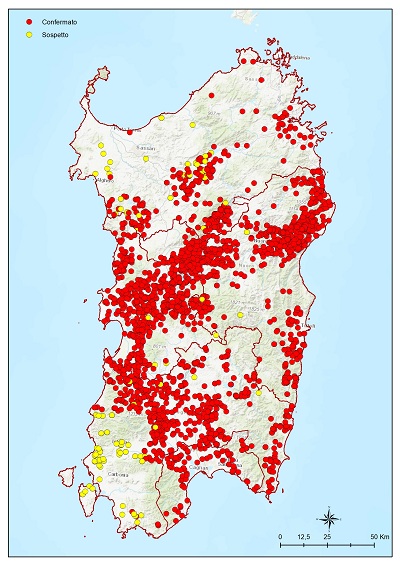IZS - Istituto Zooprofilattico Sperimentale Abruzzo e Molise
Bluetongue serotype 4 epidemic in Sardinia Region

- Figure 1. Number of suspected (yellow) and confirmed (red) BTV4 outbreaks in Sardinia region from August 2021 to mid-October 2021
Since August 2021 Sardinia region has been affected by a new Blutongue serotype 4 (BTV4) epidemic wave.
The last BTV4 epidemic occurred in 2017, while in 2018, 2019 and 2020 just a small number of outbreaks have been confirmed (about ten per year).
At the beginning, outbreaks have been notified in the east part of the region in Nuoro province, then, in the following weeks, more cases have been confirmed in the province of Oristano, Sassari, and Sud Sardinia. Up to now, the virus circulation has been detected in almost all the region with 2.096 confirmed outbreaks and 69.941 cases, 69.135 of which with clinical symptoms (Figure 1).
In Italy vaccination programmes against BT, as reported by the DGSAF Note Device n. 17522/2019 – Bluetongue Control and Management Measures on the national territory, are on voluntary basis. Every single Region or Autonomous Province may decide according to the epidemiological situation to vaccinate or not and to vaccinate all or just a part of the susceptible population.
Sardinia region, according to its geographical position and to the livestock structure, each year plan vaccination programs against BT. For 2021, the vaccination strategy was based on the mandatory vaccination of all the restocking sheep in the region with priority to be assigned to the high risky farms indicated by the regional epidemiological unit.
However, in 2021 technical issues have delayed the vaccination campaign and for this reason, only a part of the selected farms was vaccinated at the beginning of the epidemic wave.
BTV 4 epidemic in Sardinia requires some considerations.
Without a mass vaccination strategy, BTV can circulate throughout a territory with a prevalence level influenced by the immunity status of the susceptible population and by the eco-climatic conditions. If vaccination coverage is low and climatic conditions are favorable for Culicoides, the number of BT cases can rapidly increase; recent examples are the BTV1 epidemic in 2013 and BTV4 in 2017 in Sardinia.
A vaccination strategy of only restocking sheep, even if on a mandatory basis, is able to reduce damages due to mortality in this species, but only if it is performed in advance i.e. at the beginning of the vector season.
In conclusion, BT is not a zoonosis and causes different economic losses. To reduce the damages due to viral circulation it is necessary not only to promptly plan a vaccination program but to monitor it in order to limit every unforeseen delay.